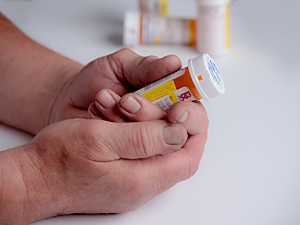The Stopping Opioids after Surgery (SOS) score, introduced in 2019 in JAMA Network Open, helps clinicians screen patients shortly after surgery for risk of sustained prescription opioid use.
Researchers at Brigham and Women’s Hospital later validated it among patients who underwent spine surgery, as reported in The Spine Journal.
Andrew J. Schoenfeld, MD, MSc, of the Department of Orthopaedic Surgery at the Brigham, and colleagues have now validated the SOS score for use after a diverse array of orthopedic procedures across subspecialties. Their report appears in The Journal of Bone & Joint Surgery, American volume.
Methods
Using the Research Patient Data Registry at Mass General Brigham, the research team identified 26,114 patients (52% female, median age 63) who underwent rotator cuff repair, lumbar discectomy, lumbar fusion, total knee arthroplasty, total hip arthroplasty, anterior cruciate ligament reconstruction or open reduction, and internal fixation of ankle fracture or distal radial fracture.
The time frame of surgery was categorized as:
- Before the COVID-19 pandemic (January 1, 2018, to February 29, 2020)
- Wave 1 of the pandemic (March 1 to December 31, 2020)
- Wave 2 of the pandemic (January 1 to December 31, 2021)
- Wave 3 of the pandemic (January 1 to March 31, 2022)
The study’s primary outcome was sustained postoperative opioid use, defined as uninterrupted prescriptions for opioid agonists, opioid partial agonists, and/or synthetic opioids (listed as schedule II or schedule III controlled substances) for ≥90 days after surgery.
As in their previous study in spine surgery, the researchers considered patients at low risk of sustained opioid use if their SOS score was <30. Medium risk was a score of 30 to 60, and high risk was >60.
Validation of the SOS Score
The overall prevalence of sustained opioid use was 4.0%. The performance of the SOS score was strong, with an overall C-statistic of 0.82.
The prevalence of sustained prescription opioid use was 1.3% in the group predicted by the SOS score to be at low risk, 7.4% in the medium-risk group, and 20.8% in the high-risk group.
The COVID-19 Pandemic
The surgery time frame was not associated with changes in SOS scores or sustained opioid use. The C-statistic was the following:
- 0.79 pre-pandemic
- 0.80 during wave 1
- 0.77 during wave 2
- 0.78 during wave 3
Applying the Results in the Clinic
The SOS is a 10-item, evidence-based bedside tool, and all items are available during patient discharge. This prediction aid thus allows orthopedic surgeons to screen patients at a time when surgeons may be best positioned to prevent opioid use from spiraling.
Low SOS scores should not be interpreted as indicating patients are safe from sustained opioid use. All patients, regardless of SOS score, should be monitored for concerning patterns of opioid use. However, those with a high SOS score are potential candidates for upstream preventive measures.
